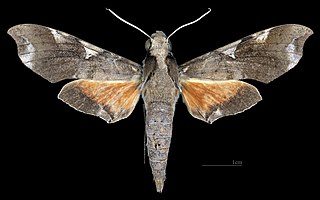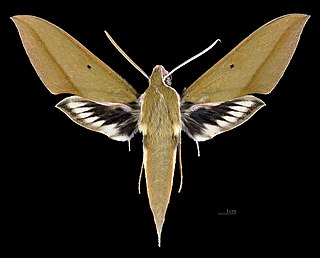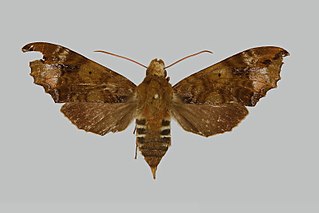
Callionima calliomenae is a moth of the family Sphingidae.

Eupanacra mydon, the common rippled hawkmoth, is a moth of the family Sphingidae.

Theretra latreillii, the pale brown hawk moth, is a moth of the family Sphingidae described by William Sharp Macleay in 1826. It is found in most of Asia, including Borneo, China, Hong Kong, the Philippines, Taiwan and also throughout the tropical and temperate regions of Australia.

Hippotion pentagramma is a moth of the family Sphingidae. It is known from the arid areas in Arabia, Somalia and Ethiopia.

Callionima acuta is a species of moth in the family Sphingidae. It was originally described by Walter Rothschild and Karl Jordan as Hemeroplanes acuta, in 1910.

Callionima denticulata is a species of moth in the family Sphingidae, which is known from Panama, Mexico, Costa Rica, Nicaragua, Bolivia, Peru and western Venezuela. It was originally described by Schaus as Calliomma denticulata, in 1895.

Callionima grisescens is a species of moth in the family Sphingidae. It was originally described by Rothschild as Calliomma grisescens, in 1894.

Callionima juliane is a species of moth in the family Sphingidae, which is known from Peru. It was described by Ulf Eitschberger in 2000.

Callionima parce, the parce sphinx moth, is a species of moth in the family Sphingidae.It was originally described by Johan Christian Fabricius in 1775.

Callionima ramsdeni is a species of moth in the family Sphingidae which is known from Cuba. It was originally described by Benjamin Preston Clark in 1920.

Xylophanes elara is a moth of the family Sphingidae first described by Herbert Druce in 1878. It is known from Paraguay, Suriname, Venezuela, Bolivia and Brazil.

Xylophanes guianensis is a moth of the family Sphingidae.

Xylophanes haxairei is a moth of the family Sphingidae. It is known from French Guiana and Venezuela.

Xylophanes media is a moth of the family Sphingidae first described by Walter Rothschild and Karl Jordan in 1903.

Xylophanes resta is a moth of the family Sphingidae.

Xylophanes schreiteri is a moth of the family Sphingidae. It is known from Argentina and Bolivia.

Xylophanes schwartzi is a moth of the family Sphingidae. It is known from Ecuador.

Eurypteryx bhaga, the hook-winged hawkmoth, is a moth of the family Sphingidae first described by Frederic Moore in 1866.

Protaleuron rhodogaster is a moth of the family Sphingidae. It is found from Ecuador to Bolivia.

Perigonia thayeri is a moth of the family Sphingidae. It is native to the island of Saint Vincent.
























